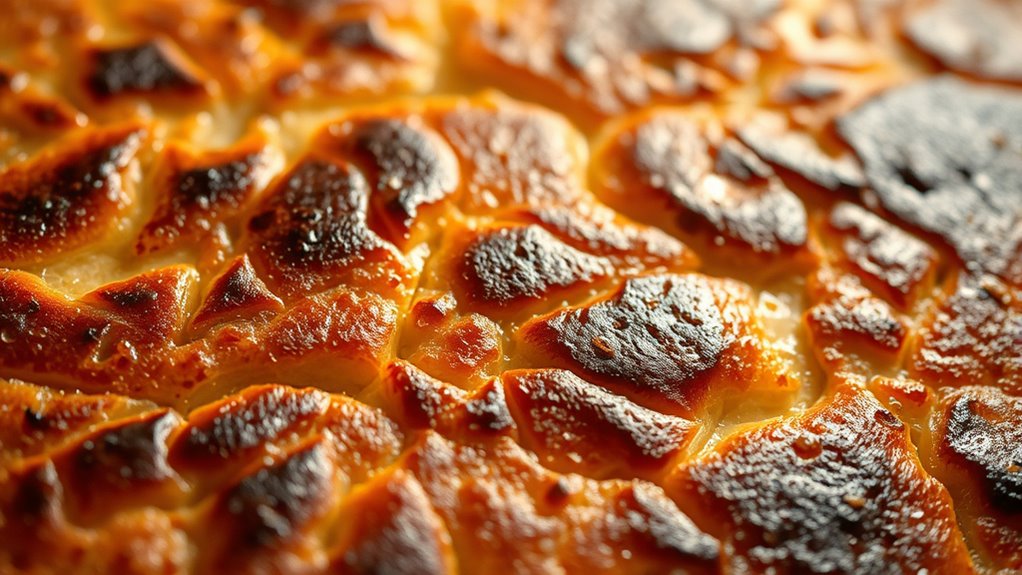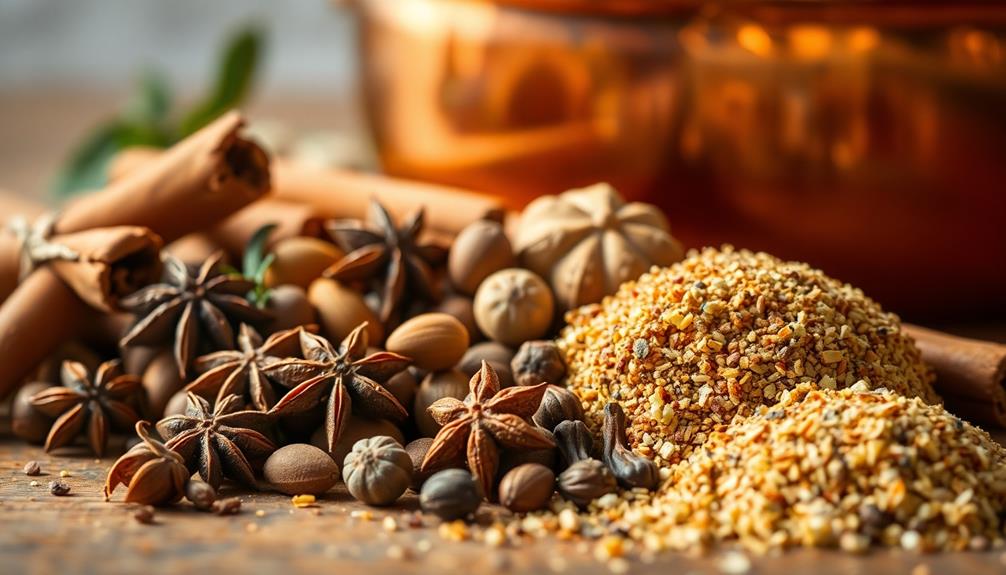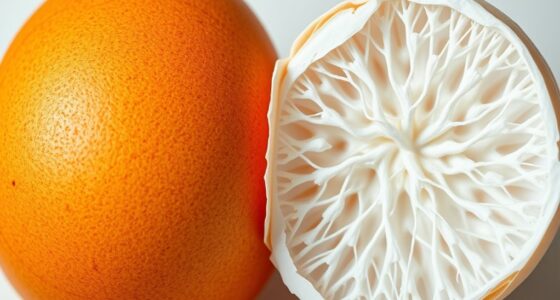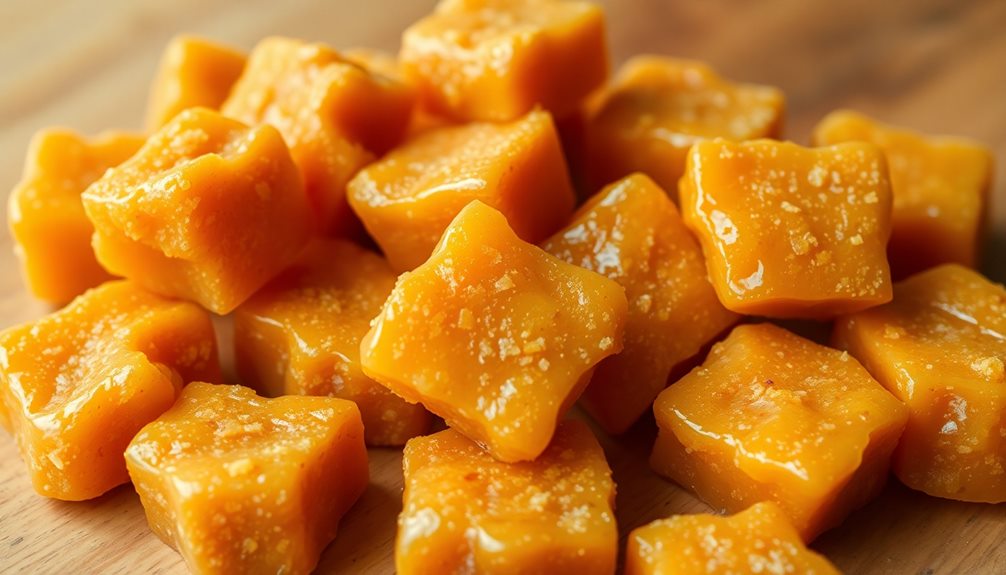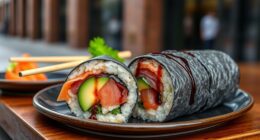The Maillard reaction is what makes browned foods taste so rich and complex. When you cook foods like grilled meat or toasted bread, heat causes sugars and proteins to interact, creating new flavor compounds and appealing aromas. This process not only enhances flavor but also gives foods their tempting golden color. Understanding how browning works can help you master delicious cooking techniques—keep going to discover how to make your dishes even more irresistible.
Key Takeaways
- The Maillard reaction creates complex flavor compounds that enhance the savory, nutty, and roasted tastes of browned foods.
- Browning develops through interactions between reducing sugars and amino acids, producing rich aromas.
- Proper temperature control speeds up the Maillard reaction, maximizing flavor without burning the food.
- The reaction also improves the visual appeal by giving foods a desirable golden or dark brown color.
- Understanding browning allows cooks to optimize flavor and appearance in baked, grilled, and fried dishes.
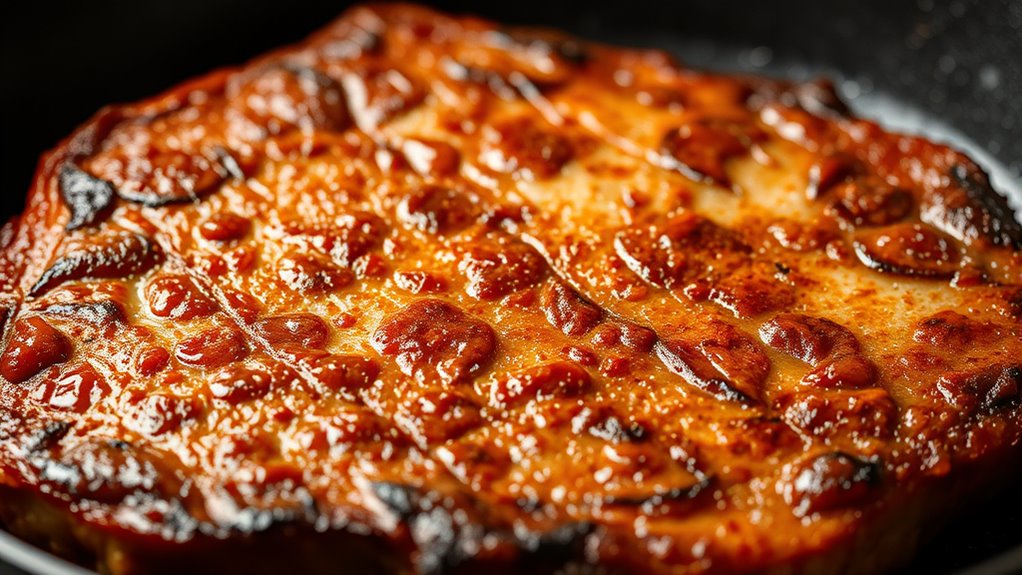
Have you ever wondered why cooked foods develop rich flavors and appealing aromas? It all comes down to chemical changes happening at the molecular level, especially the Maillard reaction. When you cook foods, you’re not just heating them; you’re triggering a complex series of reactions that transform their taste, appearance, and smell. Two key processes involved are sugar caramelization and protein denaturation, both essential to the browning and flavor development you associate with delicious cooked dishes.
Sugar caramelization occurs when sugars are heated to high temperatures. As the heat increases, the sugars undergo a series of chemical reactions, breaking down and forming new compounds. These new compounds give browned foods their characteristic sweet, nutty, and toasty flavors. Caramelization is responsible for the golden hue of roasted vegetables, toasted bread, and caramel candies. It’s a process that enhances sweetness without adding any extra sugar, simply by transforming the sugars already present in your food.
Sugar caramelization transforms natural sugars into rich, sweet, and toasty flavors, giving foods their golden color and appealing aroma.
Alongside sugar caramelization, protein denaturation plays an indispensable role in the browning process. When you cook meats, eggs, or dairy, heat causes the proteins within these foods to unfold and lose their natural structure. This denaturation exposes new amino acids and reactive groups, which then participate in Maillard reactions. As proteins denature, they react with reducing sugars, creating a complex web of new flavor compounds. This interaction is what gives seared steaks their rich, savory aroma and the browned crust on baked goods. Without protein denaturation, these foods wouldn’t develop the deep, appealing flavors that make them so tempting.
The Maillard reaction is most active at temperatures above 300°F (150°C), which is why browning occurs during frying, roasting, or grilling. It’s a delicate balance—too low, and the reaction slows down; too high, and you risk burning the food. The browning not only enhances flavor but also affects texture and appearance, making foods look appetizing and inviting.
Understanding the underlying chemical reactions involved helps you appreciate why certain cooking techniques produce such appealing results, and it can even inspire you to experiment with temperature and ingredients to achieve perfect browning every time. In particular, the Maillard reaction is closely linked to the presence of both sugars and proteins, which work together to create depth of flavor and complex aromas.
Frequently Asked Questions
How Does the Maillard Reaction Differ From Caramelization?
The Maillard reaction differs from caramelization because it involves sugar decomposition combined with amino acids, leading to complex flavor development. Caramelization, on the other hand, is solely the heating of sugars, which produces caramel flavors and browning. While both processes create delicious tastes and colors, the Maillard reaction results in richer, more savory flavors, whereas caramelization offers sweeter, more straightforward caramel notes.
Can the Maillard Reaction Occur at Low Cooking Temperatures?
Yes, the Maillard reaction can occur at low temperatures, but the reaction rate slows markedly. At lower temperatures, you might notice less browning and a milder flavor, as it takes longer for the amino acids and sugars to react. To enhance browning at low temps, you can increase the cooking time or slightly raise the temperature. Patience is key for this reaction to develop fully.
Does the Maillard Reaction Produce Any Harmful Compounds?
Yes, the Maillard reaction can produce some harmful chemical byproducts, which may impact food safety if not managed properly. When you cook foods at high temperatures, these byproducts can include compounds linked to health concerns like acrylamide. To minimize risks, it’s best to avoid excessive charring or overcooking, and maintain proper cooking temperatures. This way, you enjoy the delicious browning without compromising your health.
How Can I Enhance Browning in My Baked Goods?
Think of your baked goods as a canvas waiting for vibrant colors. To enhance browning, you can use ingredient pairing with sugars and amino acids, which act like paints. Incorporate baking techniques like higher oven temperatures and proper preheating to encourage the Maillard reaction. These steps help develop a rich, golden crust, making your baked treats irresistibly flavorful and visually appealing.
Is the Maillard Reaction Affected by Ph Levels?
Yes, the pH influence markedly affects the Maillard reaction, impacting flavor development. When you increase the pH, making the environment more alkaline, the reaction occurs faster and produces more complex, desirable flavors. Conversely, a lower pH slows the process and can lead to less browning and milder flavors. You can adjust the pH to optimize browning and enhance the overall flavor profile of your baked goods or cooked foods.
Conclusion
Now you see, the Maillard reaction is like a magic trick that turns plain ingredients into a flavorful masterpiece. It’s responsible for that irresistible brown crust on bread and the savory aroma of roasted coffee. When you cook, you’re fundamentally inviting tiny chemical reactions to dance and create delicious flavors, just like a symphony playing in your kitchen. So next time you indulge, remember—it’s the beautiful browning that makes food as tempting as a treasure chest of flavors.
